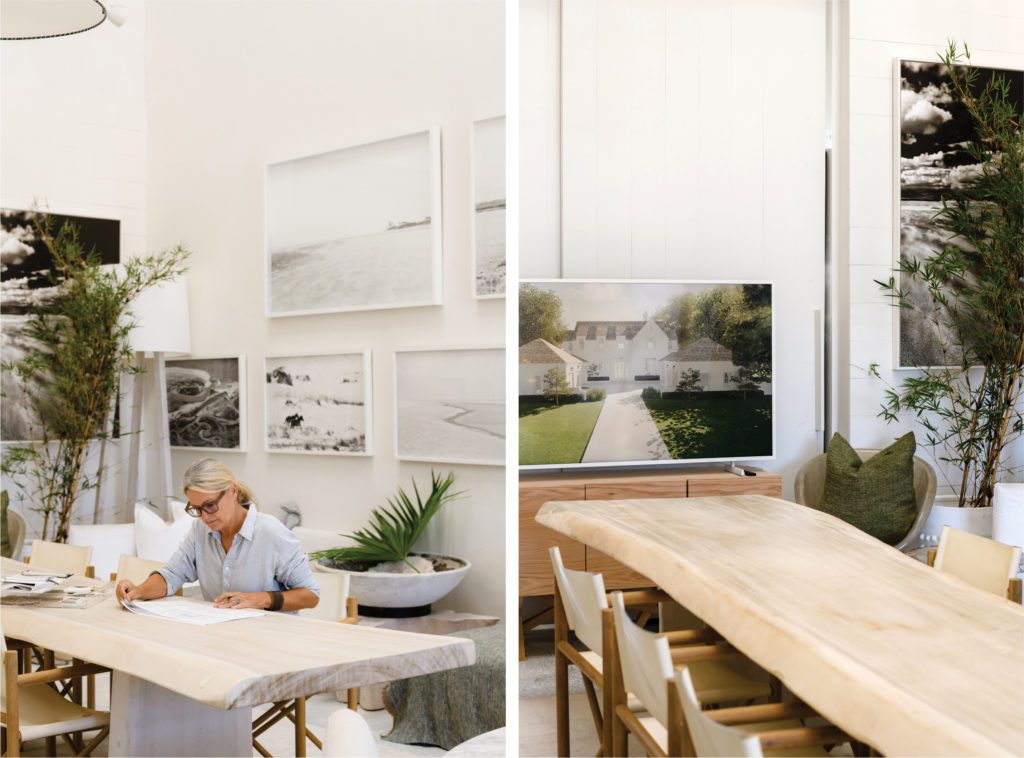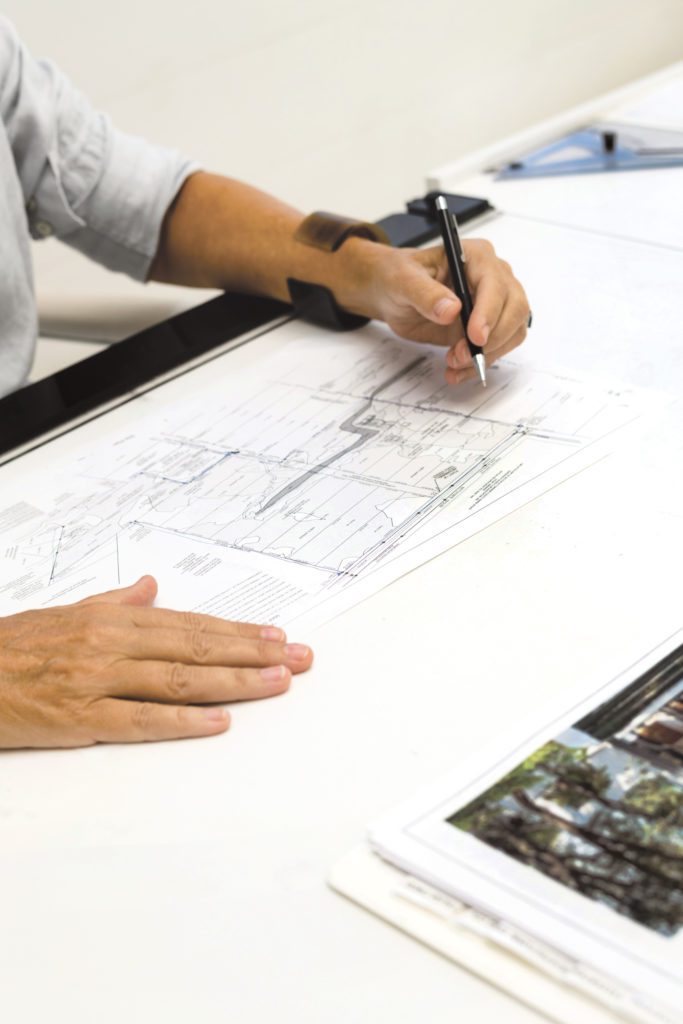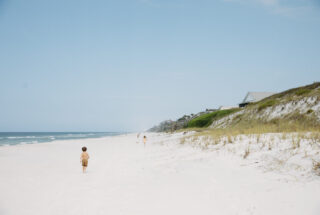Julia Starr Sanford is a woman who uses what she’s been given to create, to expand,
to change for the better. Nothing gets wasted. The places of her childhood stay with her—her descriptions of them bring scenes to the mind’s eye. Her mother’s design sense has been a force moving her toward beauty. She retains valuable knowledge about durability of materials from summer jobs in concrete. Travels inform her sense of the timelessness in design and the built world. Her work on film sets showed her the emotion of backdrop and the importance of reuse. These life experiences, this lifetime of collected perspective, offer framing for her career as an architect and designer.
And now, as she moves forward into the next chapter with thoughtful intentionality, her life and career, the whole of both, seem to have led her to this moment—one in which she’s looking ahead to a place where sustainability is more of a practice than a philosophy. She uses words like purpose and contribution, and she is thinking of what she can do that will matter most. After talking to her, you know it will be something true and real, and that she will bring all of herself, her experience, her wisdom, and her desire for a better future to bear. Just as she has done all of her life.


Cassie: Where did you grow up? And beyond that, is there anything about your early travels or interests that stuck with you and hinted at a future in the design world?
Julia: I grew up in Atlanta. My family goes back—there’s a statue of my great-grandfather downtown—many generations. We had a summer home in Florida so we spent time in Florida and we had a farm in Alabama. We spent a lot of time in both places and it informed my design sense. Florida because of the coast, the ocean breezes and the beautiful sunlight, the barefoot lifestyle. The farm because we had animals, all kinds. It was a beautiful old antebellum house surrounded by big pastures. We had sleeping porches and big screened-in porches, and a giant fireplace, walnut paneling and 14-foot ceilings. My grandmother had beautiful gardens. The whole backyard was blanketed in violets. Giant oak trees in the front. We rode horses and had big barns with hay lofts. That was a really special place. In everything I do, I somehow subconsciously combine those two things in trying to make a place that is coastal but
also real.
C: With a connection to place, earth and land, environment.
J: Yes, re-connecting with the land, the seasons and place
is everything.
C: I looked through your work online and I can see that reflected. It’s always nice when the philosophy behind the work lines up so well with how it plays out and manifests itself visually. Good for you. Did you from an early age realize you were drawn to design?
J: My father is a highway contractor. He builds in concrete. He does large projects all over the country. I went to job sites with him as a child and I ended up working for him two long, hot summers. Pouring concrete, finishing concrete, saw cutting concrete in the south Georgia heat. That definitely had an effect on how I work with materials and work with builders. My mother had great style. She wasn’t an actual interior designer but she did a lot of that kind of work for friends and family. So, yes, to answer your question. At a young age it just came naturally because of those two things. I didn’t know if I wanted to study interior design or study architecture but I ended up doing architecture. Once I started, I absolutely fell in love and couldn’t do anything else. I was obsessed. And I still do interior design as a part of it.
C: Best of both. In talking to architects who do a bit of both, it seems that having a real sense of the bones of places and how they are put together really informs all of the other choices you make in terms of furnishings and soft things.
J: It does. The furnishings and soft things add another layer of texture and color and a sensuality to the harder things, the harder corners.
C: How old were you working on a concrete job?
J: The summer when I turned 18, before I went to college, and then two summers later when I was saving money to go to Italy. I lived in Italy for a year so working in that heat paved the way!
C: It says a lot about you that working in those conditions didn’t make you run from it all.
J: No and my dad didn’t cut me any slack either. He always wanted a son so he sort of pushed me really hard [laughs].
C: Good for both of you. What gives a home longevity, a sense of both having been around, of permanence, and also that it could be around, that it could become a generational space? Like the way you talk about the farm in Alabama … how do you get there? Is it a process or is it instinctual?
J: Great question. I think throughout time homes that lasted generations were built out of stone. At least the foundation. This is important. As long as the house has really good proportions, it becomes classical and timeless. So, good foundations, good masonry, heavy timber framing, and the carpentry details are so important. I was one of the first architects invited to come to Alys—there were eleven of us in those early talks—and we got together and talked about what would make this lasting. We looked at Bermuda architecture with the stone roofs and Antigua, Guatemala with the courtyards and stone. We were all trying to create something that was timeless and beautiful. It’s about playing nicely with the neighbors and not showing off on the exterior. There’s room for expression and invention within that, but the walls and openings and courtyards are pretty timeless.
C: Simple in a way that can last.
J: Yes, and good materials.
C: Your early experience with concrete came in handy?
J: It did. Especially knowing that once it’s poured it’s really hard to change.
C: Do you think how a home sits in its surroundings—both its physical placement and the way the materials honor the environment—affects this sense of permanence also?
J: They are intimately connected. In Alys, the white is clean, it allows for beautiful shadow play, the masonry allows for the salt air and the breezes not to damage the materials. In a more rural location we’re always working around trees which are key to providing shade and cutting out heat gain on the house, protecting the house from strong winds. There are so many things really important about that, and that in today’s building world have been lost. It’s
hugely important.
C: Let’s say a client takes you out on a piece of land and they’re trusting you to design from there—how much time do you spend thinking about appropriate materials and direction of the sun and placement in relation to the trees?
J: All of those are really important. The site on the land comes first. It depends on what climate you’re in. You’re in the Southeast and you want to get some good strong prevailing winds and you want to be high up for views. Any trees that are close you want to preserve. The materials? Whatever is available and indigenous to the architecture of the area. Sometimes we’ll camp on the land and go back many times at different times of day to try to understand it.
C: I notice that you’re into art. How do you see art as a part of your design process?
J: It’s so integral. A piece of art is like a window into another world. Everything we do tends to be pretty neutral or white and art brings in a point of color and sets a personal note too. A sense of self-expression. Everything else might be background to the art.
C: Do clients want you to help them choose art for them?
J: Yes. A lot do and a lot have their own collection that they want us to help them place in the home. We love it. We have an art gallery as part of our showroom and we feature different artists and, always work to support the arts. I love that part.
C: The symbiotic nature of it is really nice, when all the different components are working together. When they all flow and connect.
J: Symbiotic is the right word. It’s all so related to each other in a way. It would feel very foreign to have someone come in and place art that didn’t have any real meaning or any relevance to the architecture of the space.
C: It has so much to do, too, with how you feel in your home. Which leads me to another question. How do you get to know what a client needs and is looking for? It’s so personal. Do you have a process or is more instinctual?
J: Both. Over the years we’ve developed questions to help pull things out. You’re working with families so you’re reconciling several ideas of a dream home into one. Asking them questions about where they’ve been, what they’ve seen, what they love. The typed-up list deals with more practical things. As you get to know them, you get to know their personalities, and it’s very intuitive then. I focus on doing lots of listening, and try not to direct anything early on. Really listening to the clients, it is their house, not mine.


C: Let’s talk about Alys and what it’s like to design a home there. You’ve been there from the beginning so you were part of the establishment of the guidelines for building. Do you find those restrictive or liberating?
J: I find it very liberating. You play by the rules and you find ways to reinvent the rules if you need to. It’s not unlimited. You’re confined to a specific lot size and height. But I find you get much more involved in the details and the intimate moments of each house and the qualities of each one of those moments. You think more about the quality of the experience, the light, the materials, the negative space. Carving out within that negative space. When you are forced to play with your neighbors in the way you are at Alys, it’s about harmonizing. I think of it like a jazz band. Everyone has their moment but in the bigger picture it’s like a symphony.
C: I love that, so nice. Less ego and more what do we all bring to the table?
J: Yes. What are we all doing together?
C: Do you do a lot of second homes or is your practice a mix?
J: A big mixture. We do a lot of primary residences too. They are completely different, the two. I like both. The second homes are usually a little bit less practical.
C: That’s fun. What in your day-to-day life gives you energy or inspires you, for lack of a better word?
J: Chocolate [laughs]. I love seeing things being built. When it goes from the brain to the page to a 3D model to a built thing. I get really excited walking through the houses. I never cease to be amazed and in a kind of wonderment of that translation from an idea to the built form. Inspired by good architecture all around, whoever, wherever.
C: Do you travel?
J: We’re starting to travel again. We have projects in Cabo, Charleston, Kiawah, Sea Island, a lot of work in the Bahamas, Costa Rica, Panama, Belize. So we kind of cover this Caribbean realm. It’s nice.
C: So you make pleasure out of this work travel?
J: I try to. We love to go to the Keys, just get in a boat and float. I’m going back to Italy this fall.
C: I’m sure you bring back parts of everything you see from
your travels.
J: Probably so, yes.
C: How do you start your day, even through travel and work?
J: I wake up and drink coffee for an hour. I try to sit outside somewhere if I can. We have an old house in Amelia, built in 1860, and I like to sit on the big porches. Here, in the courtyard. So, yes, coffee and a little yoga, a beach run. I take that time, an hour of nothing, drinking coffee
and thinking.
C: When you’re not working where are you?
J: I’m on the beach or working in the yard. I’m outside,
I’m always outside.
C: What are you drinking?
J: If we’re on a boat, we’re drinking rum. In the courtyard, we’re drinking water, some wine. In the winter, I like a Manhattan.
C: Do you garden?
J: I had a beautiful organic garden for a while. I loved it and I loved knowing I could grow food and sustain myself and my family. It just took so much time that I decided I would support local farms. We buy from nice local farmers at the farmers’ market. We do herbs and fruit trees and figs and lemons and limes and papaya. I do well with things that don’t need a lot of attention, but I like things that produce too.


C: Tell me a bit about your experience with the film business.
J: I did feature film set design for a number of years. I grappled with how quickly things are built and then torn down. The balance between that fabricated reality and the actual built world. The fabricated reality in many ways has more of an affect on people and lives longer, touches more people and has a wider audience. I really immersed myself in that and a philosophy about creating spaces that affect all of your senses in a timeless way. When you create a scene in film, what’s designed is backdrop to the drama. But it’s such an important part. It sets the stage and it’s created out of sound and light and surface and shadows. You think about these scenes in a very intimate way that translates, I think, into architecture. I started thinking about spaces in a way that was also a backdrop to the life that was going to be lived there. It had a strong affect on my design sense early on. I was also able to salvage lots of material from movie sets and repurpose those. Things that would just get thrown away—we’d find a way to reuse them.
C: For example?
J: There was a group in Atlanta that was building homeless shelters out of them for awhile. We’d make furniture out of it. Furniture is another aspect of the work I do. There’s architecture, interior design, and the furniture. We do mostly outdoor furniture, but all kinds. A lot of our furniture is throughout Alys in the parks. We try to match the architecture—bold, simple forms, timeless, really well built.
C: It’s interesting to think about film sets and how they are a backdrop for the life or scene, as you said, and how they also elicit their own kind of emotion and encourage their own reactions. Understanding how much those personal spaces matter is a real gift, I imagine, for your clients and is probably subconscious at this point.
J: I think so. I was struggling to articulate it, but it’s there. It’s just sort of part of the natural way of doing things at this point for me. It had a profound effect.
C: Is there anything else you’d like to say about your work?
J: The only other thing is I’ve come to the point where I’m thinking about the future and what’s the most important thing I can do. I’ve come to an understanding about my time and my purpose and I think it is to try to create a true sustainable vernacular for Florida. I plan on devoting the next twenty years to doing that. I don’t know what that’s going to look like. It’s part Alys, it’s part things from the Caribbean, it’s part tent dwellers. It’s part solar loft. It’s all kind of sparking around in my mind. But I have a new project that’s on a huge piece of land in Florida and that will be one of the first attempts at trying to demonstrate what it is. That’s how I hope to spend the next twenty years.
C: I feel the best of your profession are also good stewards of the land and the environment in which they’re both taking from and adding to. It’s admirable that you’re doing something with those thoughts.
J: I used to try to think I could do it globally. But coming down to it, what is the most important thing I can do? I know Florida and I understand it and the coast and the weather patterns so I’ll stay a little more localized with that. But I think creating more little boutique ecotourist kinds of projects and building lighter on the land in some places and then heavier, stronger masonry in other places. I hope in each project that we do, we’ll be able to introduce more and more of that and it’ll grow and will be a lasting contribution.
C: If it works, the local often can become more global. It makes sense to start with what you know.
J: Right.
C: It’s also raising consciousness about these ideas. The way you speak to your clients about it, for example, which gets them thinking in new ways.
J: Building an air-conditioned box is not sustainable. It’s great, you need it, but you don’t need the entire house to be air-conditioned.
C: I hope the next twenty years play out as you envision.
J: Yes, I hope so. We’ll see. The important work is just beginning.
C: It’s been a privilege to talk to you. To look over a whole career. I’ve really enjoyed it.










